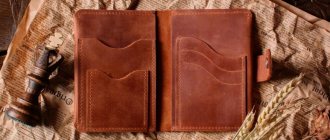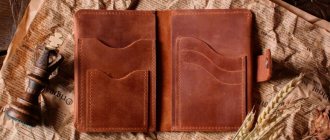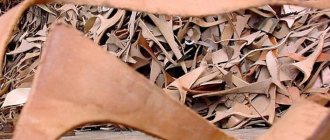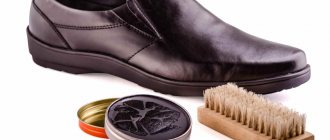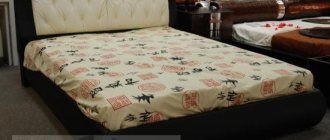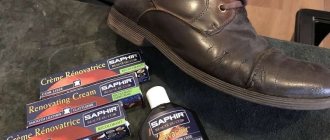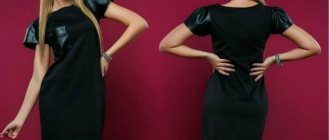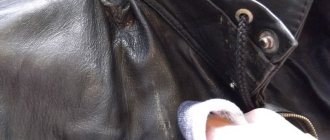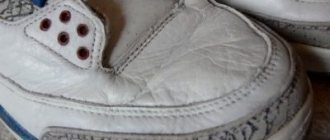Genuine leather has always attracted the attention of consumers, both men and women. Leather gloves, shoes and bags are considered the standard of quality, comfort and style.
However, today there are many options for leatherette for those who do not want to wear leather products due to ethical principles or high price. Thus, a fairly large part of buyers, for these or other reasons, choose leatherette products. These materials have a similar appearance, and are often of very high quality.
With the advent of leatherette on the textile market, low-quality goods also appeared. Some companies deliberately hide the fact that they make things from artificial leather and present them in stores at the price of genuine leather products. Also, some fakes can be made from natural raw materials with the addition of leatherette. And in this case, such goods should cost less. However, manufacturers keep hidden details and charge high prices for their products.
Creases
To determine whether a product is made of genuine leather or not, you need to hold the product in your hands. When touched, natural leather becomes warm and dry. The artificial one does not immediately heat up, but becomes slightly damp at the point of contact.
In addition, you need to bend the product. Wrinkles appear on the fold. On natural leather, when stretched, they will quickly disappear, but on artificial leather, a pronounced bending mark appears and cracks may even appear.
You can also lightly scratch the product with your fingernail. There are no scratches on genuine leather.
Types of genuine leather by animal type
Having learned how to distinguish leather from leatherette, it is important to know that it itself comes in several types that have different characteristics. For example, bovine leather is tough and thick and is used for sewing jackets, belts, and backpacks. Cow leather has less strength than calf leather and is used to make footwear in the budget sector. Calf is softer and quite durable; creases almost do not appear on it. The same soft and sheepskin leather is used to make gloves, jackets, bags and premium belts. There are also deer, goat, snake, crocodile and ostrich leather. And the same number of imitators and fakes.
Product surface
Natural leather has a soft and smooth surface with small but noticeable pores and minor wrinkles. All this appears naturally, and therefore the surface of a leather product cannot be perfectly smooth.
Faux leather may have a slight shine, but it is free from porosity and wrinkles. Its relief is the result of machine embossing, so it will always be the same type.
Checking at home
If you have a leather product at home and want to check its originality, you can do this using an extreme test. Water and fire will help with this.
More details on how to carry out a test at home will be discussed below. Try to carry out the procedure carefully so as not to damage the item.
How to test with fire?
If you have clothes or shoes made of non-genuine leather, if you bring fire to the product, the fabric will melt. You won't see any fire. Black smoke with a pungent odor will be produced. After such a check, the product will have an unpresentable appearance, as a deformation process will occur.
Genuine leather can withstand high temperatures, up to +130°C. Therefore, it is often used in the production of suits for firefighters.
How to test using water?
Lay out the product and drop a little water on it. If the fabric absorbs moisture, it means the clothes are made of genuine leather. Leatherette does not absorb moisture.
Unfortunately, this method cannot be used to test shoes. This is due to the fact that it is coated with a special impregnation so that moisture and dirt remain on the surface. If you pour water on your shoes, the moisture remains on top.
Now you know how to distinguish leather from leatherette. This can be done not only at home, but also in the store. The main thing is to carefully examine the product to understand what kind of leather the shoes or clothes are made from. This can be done by the depth and location of the pores, by the quality of the cut, or by the wrong side. At home, the test can be carried out using water and fire.
Trial by Fire
You need to bring a lit match to the wrong side of the product. The artificial leather will begin to melt and sizzle.
Genuine leather does not deteriorate. However, it is worth remembering that leather products can be treated with special substances that begin to burn when exposed to fire.
The money tree pleases with lush flowering: my secret is in caring for the leaves
Rare shot: Viktoria Isakova showed her grown-up daughter from Yuri Moroz (new photo)
Smooth and fresh skin: dermaplaning, or why a woman needs to shave her face
Checking patent leather
Patent leather products look stylish and bright. How to determine the naturalness of a given material? Patent leather, like matte leather, is quite elastic and resilient. Try to crumple the product and straighten it; there will be no wrinkles or bends left on the natural material. Place your hand on the surface of the material. Real leather will keep you warm. Natural material absorbs moisture, while drops of water remain on the surface of the artificial one. However, this method of checking patent leather for naturalness can be considered outdated. Today, leather is often treated with special compounds that make it waterproof. A specific test method is to place your hand on the surface of the product. The artificial polish should make your palm sweat.
Wrong side of the product and seams
The inside of the product should be rough and fleecy. If it is not possible to see the reverse side of the product, then you need to find a sample of leather, which will definitely hang on the tag. The natural product will be soft due to fur and lint. Artificial leather is made on a fabric basis, so it will be rougher and tougher.
You also need to carefully inspect the seams. Threads and textile backing should not be visible. If you notice something suspicious, it is better to refrain from purchasing such a product. Items made from leatherette last much less than products made from genuine leather.
You can tell the quality of the material by the emblem. Many products have special emblems that indicate the material from which the item is made. Genuine leather is indicated by a small stylized leather sign, while artificial leather has a diamond image. However, such marks are not found on all things. If the product is made of leatherette, then all parts of the product will be tucked inside and stitched. Genuine leather is usually stitched so that the buyer can see the edge of the material.
Any leather product must have a quality certificate attached, so you can ask the seller for it to check the authenticity of the product.
Found a violation? Report content
Advantages of genuine leather products
- Products made from genuine leather look much better and more solid than those made from leatherette. In addition, they are durable and practically do not wear out during long-term wear.
- Genuine leather is highly durable. For example, a travel suitcase made of leatherette may burst if you put too many things in it. This will not happen with natural material.
- Products made from genuine leather are resistant to the environment. They are not afraid of temperature changes, wind, cold, snow and rain.
- Easy to care for. Dark items made from dermantine can be cleaned just as well as those made from genuine leather. The same cannot be said about light ones. For example, a beige leather bag will retain its natural color. It is enough to wipe it with a sponge in soapy water. And the surface made of light dermantine will absorb dust and dirt, and after a while it will change color.
In terms of its qualities, genuine leather is significantly superior to leatherette. Therefore, before purchasing new things, be sure to take this into account.
Differentiation methods not used in the store
If after a visual inspection there are still doubts, you can test the product with water and flame. You are unlikely to be allowed to carry out such experiments with skin in a store. Experiments with heat and water are most often carried out at home.
Reaction to water
If you drop a little water on genuine leather and it is gradually absorbed, then it is not a fake. Water drains from leatherette and leaves a dry surface and a white mark behind. Even if you completely wet the leatherette, only its lining will absorb water. Water will drain from the outside without penetrating inside.
Wet items made of genuine leather can be ironed with a warm iron without steam through a gauze cloth. In this way, small creases from the skin are removed.
Reference!
Genuine leather should not be dried on a radiator or with a hot iron. After drying, it will change its size downward and lose its appearance.
Experience with fire
If you take a small sample of leather and bring it to the flame, the result will immediately allow you to distinguish a fake from a natural product. The leatherette immediately melts, and the leather gradually begins to deform, shrink and emit the smell of burnt hair.
Feel the fabric
When in contact with human body heat, real skin heats up quickly. So if you hold the material in your hands and it remains cold, know that you are dealing with leatherette.
Genuine leather feels very soft and elastic to the touch. Try to press hard on it with your finger. If the place of the print is restored almost instantly, then you have a natural material.
Introducing stretch leather
DIY shoe rack
Stretch leather occupies a strong position in the fashion industry market. Present in the collections of fashion designers who like to use it for tight dresses and skirts, trousers and leggings, as well as in decorative elements and accessories. Why is this and what is stretch leather?
It is a thin and elastic material that stretches without cracking or damage. It consists of several layers, where the base is cotton fabric, on which a polymer coating is applied on both sides. The textile layer may contain the addition of elastane, polyacrylic or polyamide. The artificial knit base gives the skin stretch by 30%.
The surface of the material attracts with its varnish smoothness and shine. The canvas is also produced with a matte front side.
Stretch leather is used to make clothes, handbags, coats, suits and shoes. The products fit tightly to the body, emphasizing the dignity of the figure and sexuality.
The most popular material is black, although it is available in a rich palette.
Modern technologies make it possible to obtain natural stretch leather by combining a layer of thin sheepskin with a cotton textile base. The material is of high quality and durable, with the ability to stretch by 20%. Looks attractive.
How to tell if shoes are leather or not
If you are heading to a store or market for a new pair of shoes, also be guided by criteria that will help you find out the history of the origin of the material and distinguish a fake from the original. This point is very important, because you will have to walk in shoes in different weather conditions. A quality product will prevent your feet from sweating, getting wet, or freezing and guarantee comfort while wearing.
Natural shoes must be marked (small sticker) with graphic marks. It contains information about the upper and lower parts of the shoe, lining, and sole. Here you must indicate information about the material, which makes up 80% of the upper of the model, the lining, insole and 80% of the sole. If there is no material from which 80% of the shoes are made, then only 2 main raw materials used for its production are indicated.
High-quality shoes always bear the mark of the leather that was used in the production of the product. This is a small piece of pressed leather in the shape of a diamond for artificial raw materials and a figured badge for natural ones. In different languages, this sample may be written as follows: leather (in English), vera pelle (in Italian), cuir (in French) and echtleder (in German). This secret will also help you distinguish a fake from the original.
If you touch the underside of natural raw materials, it will be fleecy, but artificial material will not. The front side of genuine suede is also covered with a small thick pile. If you run your hand, the color of the product should visually change slightly. This way you can always distinguish natural suede from its low-quality fake.
Appearance and cuts
You need to pay attention to the folded edges of the product. In natural leather, the outer fold resembles a rounded roller; in artificial leather, the fold is flattened, and it is also thinner. Examine the reverse side of the material in sections; the fake will have a textile base. In a high-quality product, it is impossible to do this at the seams, since they will all be hidden, but on the internal seams you can try to find an open cut and see the reverse side, the wrong side of the raw materials used.
How to distinguish leather from imitation
Rating of the best deodorants for shoes against odor
The store has a very large selection of leather goods. At the same time, sellers are not always truthful with the buyer and may offer artificial material under the guise of natural material.
It will also be useful to have an idea of the types of leather, since the area of application depends on its properties.
Kinds
- Boiled. The leather is highly durable and quite lightweight. It got its name from the method of dressing. In ancient times it was used as armor or in book bindings.
- Vegan. The starting material is cattle or pig leather with a thickness of one cm. It is used in ethnic costumes, accessories, holsters and saddles.
- Velours. Absolutely any skins are suitable for its production. The finished version looks like this: on the right side is the bakhtarma (that is, the fleecy part), on the left is the mereya (leather part).
- Suede leather. The starting material is the skins of wild animals. The material is soft, velvety and wear-resistant. It is covered on both sides with short dense pile.
- Laika. Made from the skins of lamb or kid. The feel of a product made from such leather is soft and plastic. Mereya is smooth and without wrinkles. Gloves and rarely jackets are made from this material.
- Nappa. When finished, it is a very thin material (up to 1 mm) and elastic. Made from the skins of cows, bulls or sheep. Nappa is used to make bags, accessories, hats and clothing. Main producers: Italy, Spain and Türkiye
- Napplak. This is a type of nappa, only varnished.
- Nubuck. Externally very similar to suede. Its difference is that it is made from the skins of cattle.
- Deer. Quite durable material that holds its shape and retains heat well. Feels like suede. Very rarely found on sale, so they are expensive.
- Parchment. Produced from the skins of lamb, goat and calf. It is used in the manufacture of musical instruments, car trim, book bindings and accessories.
- Morocco. Made from the skins of calf or sheep. The quality of this material is thin, soft, wear-resistant and comes in different colors. Bags and cases are made from it.
- Split. Made from pig skins. As a result, a material of different thicknesses is obtained, which is used in the production of various products (from haberdashery to outerwear).
- Cheprak. It is made from skins taken from the backbone of cattle. It has significant density and thickness.
- Shagreen. It is made from the skins of the spinal part of small cattle or horses. Often colored green. Has a bumpy surface. Depending on the method of dressing, soft and hard shagreen is distinguished.
- Chevrette. This material is dense and elastic. Made from sheep skin.
- Kid. The basis for production is goat skins. It differs from chevrette in its “fine wrinkle” pattern. The material is soft, dense and durable.
- Shora. The production is based on cow or bull skins. It differs from saddle cloth in that it is denser and thicker.
- Yuft. It is made from the abdominal part of the skin of a cow or bull. It is distinguished by softness and plasticity.
There are a lot of varieties of material. It is difficult for an inexperienced person to understand it. Therefore, it is better to learn to distinguish it from artificial one.
There are not so many types of leather imitation. Its application depends on the base. Since different materials provide different elasticity and strength.
Types of artificial leather
- Dermantin. The basis of this material is cotton. Nitrocellulose coating (on one or both sides).
- Kirza is cotton coated with rubber.
- Vinyl leather is a synthetic fabric coated with polyvinyl chloride. Maximum imitates natural leather.
- Stretch leather. The base is knitwear. Polymer coating.
- Eco leather (PU). Widely used in modern products. It is based on defective genuine leather. The coating is made of high quality polymer coating.
- PVC. The basis is fabric. PVC coating with added plasticizer.
Heat exchange
The material is designed to protect the body from cold and heat. Therefore, its entire structure is aimed at these functions. Even the most modern artificial material has much worse heat transfer.
Therefore, when choosing clothes or shoes for a cold winter, it is better to give preference to natural materials. You won't feel hot or cold in this product. Also, genuine leather is elastic and takes the shape of its owner. Such shoes will not press, causing discomfort.
Wrinkling
Leatherette only looks like genuine leather. It does not have all the qualities and benefits of natural. It is less elastic and therefore quickly cracks and bursts. Genuine leather does not have such defects. It simply takes the form of the person who wears it.
What can you do in a store to distinguish products?
There are certain methods that are usually used in stores and markets. If it was not possible to recognize leatherette using the above methods, and doubts remain, you can try the following manipulations:
- Warm it by hand and check the heat transfer.
Place your hand on the material. If it quickly feels warm and does not become moisturized, then you have real skin. Leatherette takes a long time to heat up and become moisturized, that is, it does not allow heat to pass through. - Pay attention to the smell.
If the manufacturer has not taken care and has not scented the artificial leather, it can be given off by a pungent odor of the chemicals used to process the product. Natural material has its own specific pleasant smell. - Examine the label (shape, inscription), check the presence and shape of the tag.
On things that are made in a factory, manufacturers usually designate the material with a label with a special symbol or inscription. Leather is usually designated on a small piece of the product with the mark: “genuine leather”, natural leather, etc. Leatherette is usually indicated by a diamond icon or the word "Leather".
Important!
Leatherette is any product that has been subjected to chemical treatment. That is, even if the animal’s skin has been treated with chemical solvents, it cannot be considered natural.
Distinctive characteristics of genuine leather
Different types of leather are needed to produce bags, shoes and clothing. Depending on the manufacturing method, they have different properties - strength, breathability, thickness, wear resistance. There are the following basic methods for processing natural materials:
- Raw. This skin goes through the processes of liming and fleshing. Initially it is soft and elastic, but hardens after drying. This property is used to give leather shape, for example, when covering drums.
- Tanned. This method of manufacturing is the most common; it imparts strength, durability, and ductility to the material. Tanning is done in different ways (chrome, vegetable, zirconium, fat, synthetic), such material is soft, elastic, water/heat resistant.
- Raw food. This leather is tanned with aluminum alum and used in the production of saddlery and orthopedic shoes.
Each method of dressing gives the skin certain properties. Features and characteristics that help distinguish natural types of matter from each other are as follows:
| Name | Processing method | Characteristics |
| Chrome tanned goatskin | Beautiful appearance, pronounced grain, density, elasticity, moisture resistance, wavy edge | |
| Shagreen leather | Vegetable tanning with alum from different types of skins (lamb, horse, goat, donkey) | Fine-grained surface, soft, embossed, beautiful pattern |
| Chrome tanning of various hides followed by varnishing | Smooth or embossed, shiny, flexible, durable, waterproof, soft, stretch | |
| Tanning skins of elk, deer, sheep, goat | Low pile, soft, breathable, high wear resistance |
Which is better to choose?
Painting shoes in Moscow
It’s not always possible to immediately figure out what is better – eco-leather or leatherette! Let's look at a few examples, shall we? If you are buying shoes, clothes or a bag, you should give preference to eco-leather:
- It allows the body to breathe;
- Retains moisture - you don’t risk getting wet;
- You don't have to worry about allergies;
- A high level of strength and wear resistance is guaranteed;
- The products are easy to care for.
In comparison with these characteristics, leatherette loses in all respects, winning on one point - a much lower price. If you often change bags, jackets or shoes, you can buy a substitute, it is much cheaper. You won't have to regret spending money if it doesn't matter what the quality is!
How to figure out which canvas to give preference to in furniture? The difference is obvious!
If you are buying a sofa or chair for public places (for example, a reception room), you can choose leatherette. For little money you will get attractive furniture that will last for several years - and you practically don’t need to care for it;
If you want to purchase furniture on which you will sit constantly, the choice should fall on eco-leather. The canvas is soft and pleasant to the body - you don’t have to sit on a cold, hard surface. In addition, it can easily withstand even intensive use.
We told you about the difference between eco-leather and artificial leather - were you surprised by the secrets revealed? Now you can choose the ideal material for furniture, clothing or other items that meets your wishes, comfort and safety! Read on to learn how to wash sneakers in a washing machine.
